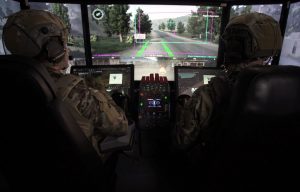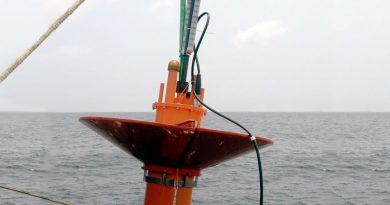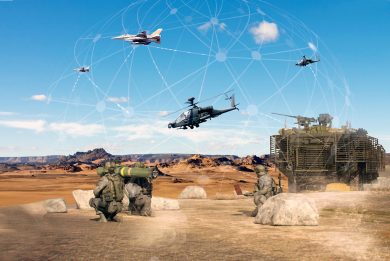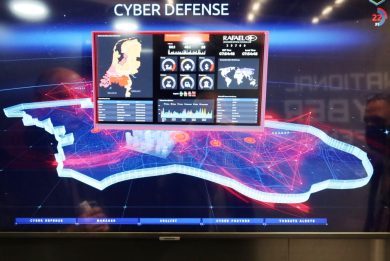
First-ever “live” test drive of Rafael’s Transparent Cockpit Next Generation Combat Vehicle
6 August 2019
By Paolo Valpolini
In a 10 minutes video streaming Rafael of Israel introduced its suite designed to reduce the crew workload in future armoured vehicles, allowing soldiers to fully operate with closed hatches while having a complete awareness of the surrounding scenario. The demonstration was carried out using a modernised M113 fitted with the company-developed transparent cockpit design, enabling 360-degree situational awareness, using augmented reality for real-time battlefield information and data. The M113 was deployed at the Elyakim Army Base, in northern Israel, as part of a demo including other systems of the same type developed by competing companies.
The Rafael’s system allows to see the 360° scenario split between the front 180°, usually seen in the top half of the virtual cockpit, and the rear 180° shown in the lower part; should a threat be identified in the rear sector it is possible to shift the views.
Augmented reality is fully exploited to show points of interest on the screen, touching the screen allowing i.e. identifying a potential target, which is immediately shared with the other vehicles in the formation.
The two soldiers, the commander and the operator, split sectors and tasks, allowing optimising the workload, the system permitting to halve the number of crewmen from four to two. Usually the commander in charge of the mission control, while the operator handles the attack management and ensures defensive observation.
 The demonstration simulated an attack against an urban environment, Elyakim being one of the MOUT training areas of the IDF. Once reached the viewpoint on the hill the commander looks at the scenario in front of him, scanning for any possible threat, the system then planning automatically the route of attack. To further check the situation a Rafael’s Firefly UAV is launched; this VTOL unmanned system, in the 3 kg MTOW class, is not only capable of carrying out the reconnaissance mission, but if needed can also be used to execute an immediate attack, as it is in fact a loitering munition, fitted with a 350 grams omnidirectional fragmentation warhead. The attack version has 15 minutes loitering time, while swapping the lethal payload for a second battery allows doubling that time. All targets acquired are shown on the virtual cockpit and can be selected by a touch, an Automatic Target Recognition (ATR) being embedded in the system; this allows understanding the type of target, proposing the better lethal system for the engagement, thus reducing the time of the firing action to a few seconds since the operator touched the screen.
The demonstration simulated an attack against an urban environment, Elyakim being one of the MOUT training areas of the IDF. Once reached the viewpoint on the hill the commander looks at the scenario in front of him, scanning for any possible threat, the system then planning automatically the route of attack. To further check the situation a Rafael’s Firefly UAV is launched; this VTOL unmanned system, in the 3 kg MTOW class, is not only capable of carrying out the reconnaissance mission, but if needed can also be used to execute an immediate attack, as it is in fact a loitering munition, fitted with a 350 grams omnidirectional fragmentation warhead. The attack version has 15 minutes loitering time, while swapping the lethal payload for a second battery allows doubling that time. All targets acquired are shown on the virtual cockpit and can be selected by a touch, an Automatic Target Recognition (ATR) being embedded in the system; this allows understanding the type of target, proposing the better lethal system for the engagement, thus reducing the time of the firing action to a few seconds since the operator touched the screen.
Coming to a junction, the commander does not want crossing it without a visual check; the system shows a possible route, highlighted in green on the scenario, however a red sign indicates an IED, intelligence having acquired images of the opponent who planted it, thus the system starts automatically to plan an alternate route.
We can in fact consider the M113 to be operated by a three-element crew, two being human, the third being the system itself, which automatically plans the mission, proposes navigation solutions, scans with both the medium calibre and the small calibre weapon stations ensuring simultaneous weapons allocation, the ATR doing also its part of job when coming to the engagement sequence. Artificial intelligence has a key role in most functions of the new system. Of course the system takes in count all information coming from outside thanks to networking, such as Blue Forces locations, Points Of Interest identified by all other vehicles that fall into its operational range, etc.
Rafael is targeting two major programmes currently under way, one being the Carmel, the future Israeli Army infantry fighting vehicle, the second being the US Army New Generation Combat Vehicle (NGCV). The Israeli company looks at fully developing its system within the next five years.
Photos courtesy Rafael



